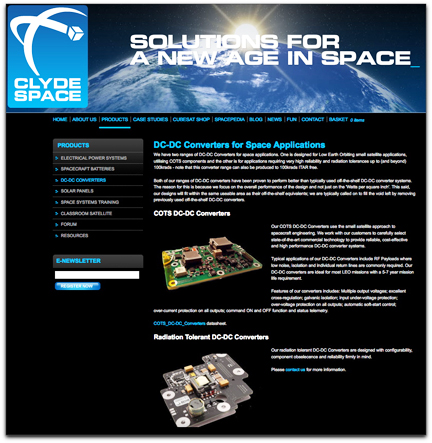Clyde Space have developed a fully isolated, multiple output DC-DC Converter for the SiREUS coarse rate sensor that is planned to fly on the European Space Agency Sentinel-3 mission. The DC-DC converter is radiation tolerant to 100krads and designed to meet the mission radiation single event effects requirements.
The most unique element of the design is that it meets these requirements and is ITAR free. The DC-DC Converter provides four low power output voltages for the supply of an FPGA and analogue circuitry with a further 50V+ output voltage for biasing. The unit delivers around 5W of power from a supply voltage of 22V – 37V. SiREUS (European Silicon Rate Sensor) is a Coarse Rate Sensor and is being produced by a SELEX Galileo in Edinburgh, building on their extensive heritage in the supply of gyros for the space market. This ESA funded development by a UK consortium will result in an ITAR free SiREUS forming a key part of Attitude and Orbital Control Systems. The design is robust and radiation hardened to provide a 3-axes MEMS based gyro solution targeted to be used on Geostationary satellites as well as applications in LEO Earth Observation, Scientific and Exploratory space missions. The single 11×11x17 cm box unit contains all control, processing, power and interface requirements.
Craig Clark, Chief Executive/Technical Officer at Clyde Space, says, "We were delighted to be selected to supply the ITAR free DC-DC Converter for the SiREUS rate sensor. Our power electronics skills have been thoroughly tested in order to come up with a design that doesn’t rely on ITAR controlled parts, and the finished unit is testament to the hard work of the team here. Clyde Space has succeeded in developing an ITAR free radiation hardened power supply where more established space power companies have struggled to find a solution." SiREUS with the Clyde Space DC-DC converter is baselined on the Sentinel-3 program as one of a series of satellites designed to meet the observing requirements of the Global Monitoring for Environment and Security (GMES) joint initiative of ESA and the European Commission to establish operational environmental monitoring systems. Sentinel-3 will provide global ocean, ice and land vegetation observations. Its launch is scheduled for 2013.


